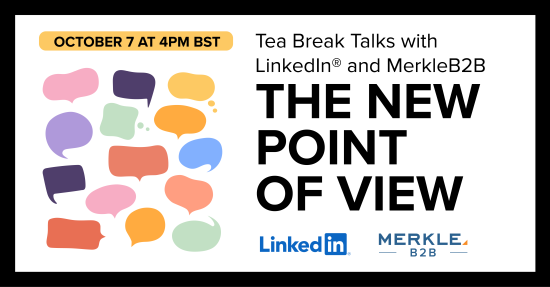“The new point of view”
I recently took part in Merkle B2B’s first Tea Break session with LinkedIn along with Conor Wilcock (Director, B2B International), Laura Pierce (Head of EMEA Performance Media, DWA) and Tusar Barik (Marketing Lead, Agency & Channel Partnership, LinkedIn). The session was based around recent survey findings from B2B International and LinkedIn around the ‘new point of view’ facing businesses as they start to emerge from the COVID crisis.
Here are some of the key points we discussed in the session.
(You can also view the whole discussion online by clicking below)
To set the scene
As we all know, 2020 has presented new challenges to all of us. COVID has presented businesses and customers with a huge amount of economic uncertainty and change. COVID has drastically changed how we all operate and how companies plan business & marketing strategies.
In Our B2B Tea Break session, we discussed the impact of COVID, what the new normal looks like and how we can adjust our marketing efforts to suit this new normal and stay agile around this ever changing economic and personal environment.
The impact of COVID on businesses
The research from B2B International highlighted the impact of COVID as having “economic” and “practical effects”. Some of the key points we spoke about:
-
First, economic impacts: 60% of companies report lower revenues than a year ago. This is especially pronounced among small businesses with fewer than 50 employees
-
Personal/consumer services, tourism, hospitality and the arts are worst affected sectors economically. Tech has been least affected (though half of tech businesses report lower revenues)
-
The impact of COVID goes far beyond the immediate economic hit. Three key practical effects relate to supply chain, technology and productivity
-
There are also differences by business size – in terms of top two concerns, enterprises were more concerned about the workforce adapting to WFH, and SMEs more around business survival and cash flow. Specifically:
-
Enterprises were most concerned with employee ‘health and wellbeing’, and ‘technology issues around adapting to WFH’
-
Whereas the top two concerns of SMEs were around sales & revenue, and uncertainty around future customer demands
-
The LinkedIn research had similar findings. Business is segmented into:
-
Business Disrupted – Significant impact and needed to pause/severely impacted (i.e Travel, Auto, Luxury)
-
Business Unusual – Temporary Changes, need to re-prioritize (i.e. Banking, Education, Non-Profit)
-
Business Evolve – Quick adaptation, growth acceleration (i.e. Software, Cloud, Hardware, Telco)
LinkedIn’s COVID impact on B2B Execs study found “almost 75% of B2B Execs are focused on preserving cash and over 60% only want to buy familiar/reliable products”, making sales cycles longer than ever.
The customer mindset
The LinkedIn research showed that the new customer mindset also has an impact on the strategic priorities of B2B companies.
-
56% of our businesses are taking a “community-minded approach” – how can we help communities, suppliers, and employees (especially during the pandemic/challenging times)
-
There is a focus on Thought Leadership – 84% using thought leadership to strengthen their position and gain trust
-
There is also a need to better segment
-
62% of businesses are focused on better understanding their “Customer’s customer”
This aligns with some of the findings from the B2B International survey:
-
We may find companies becoming less “human” with their customers – fewer face-to-face visits, more automation and self-service
-
An acceleration of the digitalization trend, which many companies were forced into during the pandemic
-
Developing direct channels (e.g. e-com, Direct to Customer and developing “last mile” infrastructure)
Differences by sector
With these potential strategic shifts in mind, we also discussed some of the differences in how certain industries will be recovering from the pandemic, and the strategies they are employing:
-
Companies are looking to act more responsibly (with internal and external stakeholders, such as employees, customers, the community and the world). Their marketing strategies will need to reflect this
-
Sectors which appear to be performing relatively well and have better prospects for recovery: Financial Services, Manufacturing and Tech
-
Sectors which have struggled more and are less confident in recovery: Tourism, Hospitality, Arts, Transport/Travel
The impact on marketing
Considering many businesses will be shifting their strategic approach, we discussed what this means for marketing. The research from LinkedIn has some clear findings:
-
Focus on building community and build for the long term (easier said than done)
-
The survey found large gaps in what people said they believed vs their actions
-
Almost a 25% gap in needing to “better understand customer” vs actually doing anything about it
-
11% difference on “needing to reposition mission, offerings, and purpose” vs doing anything about it
-
-
There is a lot of pressure to hold marketing accountable (more than before to sales)
-
46% of Marketers report being tied more to revenue
-
55% of these are focused on efforts around existing offerings vs net new to avoid spending net new cash/resources
-
-
All that said, it is important to make sure companies understand their customer’s position (and their customers’ customer), how can they help them understand the situations and solve problems from them to put them in a position of strength
The new B2B point of view – what does this mean for B2B companies?
The research from B2B International gives us some indications as to what the ‘new normal’ will be for B2B marketing, and where there may be opportunities for businesses.
-
Some things never change: CX and innovation remain top of the list of marketing priorities
-
However, top-of-funnel activity has declined significantly
-
The key to recovery and coming out of this ahead of the competition is in developing a better and deeper understanding of a company’s markets and customers. Demonstrating this understanding in clear ways is a major priority, e.g. the number 1 focus area for professional services companies is developing a thought leadership position
-
With companies looking to act more responsibly (with internal and external stakeholders, such as employees, customers, the community and the world), their marketing strategies will need to reflect this
-
We have also identified a group of ‘boomerang’ firms – those extremely confident of recovery and increased profits over the next 5 years. The biggest difference for them is a real focus on using insight and understanding the customer, and also an investment and shift to eCommerce and serving more customers through digital channels
The LinkedIn research also provides from recommendations for B2B executives. In particular, there are 5 key opportunities for strengthening positioning:
-
Use the time to position your offerings as a long-term solution for now and beyond
-
Segmentation is more important than ever, and knowing your customer’s customers positions
-
Stronger alignment with Sales and Marketing – now more than ever there needs to be more customer touchpoints – sales and marketing should gain alignment on the best way to provide air cover and align on how to handle touchpoints
-
To that point, have a focus on enhancing the customer journey, especially the digital customer journey
-
Utilize Thought Leadership to build trust, in an authentic way
Final thoughts
Although it’s tough out there for many companies – there are companies that are feeling confident about the future, and many companies that have adapted out of necessity.
There are untapped opportunities for b2b businesses that can invest in, and excel in customer experience, digital experience, and refreshing their value proposition around a new and deeper understanding of their customer.



